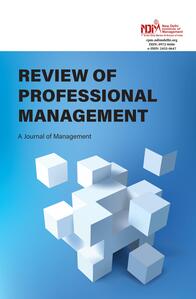
1 Humanities and Management Science Department, Madan Mohan Malaviya University of Technology, Gorakhpur, Uttar Pradesh, India
Creative Commons Non Commercial CC BY-NC: This article is distributed under the terms of the Creative Commons Attribution-NonCommercial 4.0 License (http://www.creativecommons.org/licenses/by-nc/4.0/) which permits non-Commercial use, reproduction and distribution of the work without further permission provided the original work is attributed.
Forecasting of stock prices is a very important subject in the financial world and economics. For many years, investors have been interested in making better forecasting models. The autoregressive integrated moving average (ARIMA) model was used previously for time series forecasting. This article shows the process of stock price forecasting using an ARIMA model. Historical stock data for analysis is obtained from the National Stock Exchange (NSE) and is used along with the stock price for forecasting using an ARIMA model. The result obtained from an ARIMA model is better for short-term forecasting and can be proven with existing methods for stock price prediction.
ARIMA model, stock price prediction, stock market, short-term prediction
Adebiyi, A. A., Adewumi, A., & Ayo, C. (2014). Comparison of ARIMA and artificial neural networks models for stock price prediction. Journal of Applied Mathematics, 2014, 1?7.
Babai, M. Z., Ali, M. M., Boylan, J. E., & Syntetos, A. A. (2013). Forecasting and inventory performance in a two-stages supply chain with ARIMA (0,1,1) demand. Production Economics, 143, 463?471
Contreras, J., Espinola, R., Nogales, F., & Conejo, A. J. (2002). ARIMA models to predict next-day electricity prices. IEEE Transactions on Power Systems, 18(3).
Ertekin, S., & Büyükahin, Ü. Ç. (2019). Improving forecasting accuracy of time series data using a new ARIMA-ANN hybrid method. Neurocomputing, 361, 151?163.
Khashei, M., Bijari, M., & Ardal, G. A. R. (2012). Hybridization of autoregressive integrated moving average (ARIMA) with probabilistic neural networks. Computers and Industrial Engineering, 63(1), 37?45.
Lee, C., & Ko, C. (2011). Short-term load forecasting using lifting scheme and ARIMA model. Expert System with Applications, 38(5), 5902?5911.
Lee, K., Sehwan, Y., & Jin, J. J. (2007). Neural network model vs. SARIMA model in forecasting Korean stock price index (KOSPI). Issues in Information Systems, VIII(2).
Merh, N., Saxena, V. P., & Pardasani, K. R. (2010). A comparison between hybrid approaches of ANN and ARIMA for Indian stock trend forecasting.
Meyler, A., Kenny, G., & Quinn, T. (1998). Forecasting Irish Inflation using ARIMA Models. Paper presented at Central Bank of Ireland Research Department.
Nayak, A., Pai, M. M. M., & Pai, R. M. (2016). Prediction models for Indian stock market. Procedia Computer Science, 89, 441 ?449.
Sterba, J., & Hilovska. (2010). The implementation of hybrid ARIMA neural network prediction model for aggregate water consumption prediction. Journal of Applied Mathematics, 3(3), 123?131.
Wang, C. (2011). A comparison study of between fuzzy time series model and ARIMA model for forecasting Taiwan export. Expert System with Applications, 38(8), 9296?9304.
Wang, J. J., Wang, J. Z., Zhang, Z. G., & Guo, S.P. (2012). Stock index forecasting based on a hybrid model. Omega, 40, 758?766.